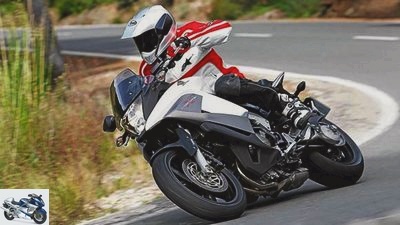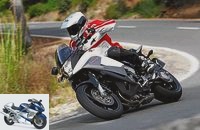Menus

Honda
Driving report: Honda Crossrunner
The best compromise in the motorcycle world?
Not that it screwed up the first, on the contrary: the VFR was an excellent and hugely successful motorcycle. Now she is given a second chance as a crossrunner, should the success story continue. With almost the same technology, but with a new character.
Tlaying is out. Spoiled Golfs dragging on the ground or 3-series BMWs bobbing over transverse joints are no longer popular. Nowadays, the broad mass of people who drive cars enjoy a good view of the distance in raised pedestals. Vans, off-road vehicles and sport utility vehicles are all the rage. This also applies to the two-wheeler sector. There, too, the raised seat concepts are on the advance. After all, the most successful motorcycle in recent years is nothing more than an SUV, the BMW R 1200 GS.
Honda already had a lot to offer in the long-legged segment, especially Varadero and Transalp. Both concepts are more touristic. Now another, almost European approach is coming from Japan: Honda’s Crossrunner. A machine that can be assigned to the Funbike category, it is very similar to the successful Ducati Multistrada. And even if it is a different displacement and performance class, the path is definitely comparable. Like the Duc, the Honda is derived from an existing street sports car, but it is still unique because of the four-cylinder engine that is unprecedented in this field.
Buy complete article

Driving report: Honda Crossrunner
The best compromise in the motorcycle world?
Crossrunner there, your nose sleek in the wind. Under the plastic dress styled in Italy is essentially the technology of the good old 800 VFR. Not only does the entire drive unit come from the tried and tested street athlete, almost the entire chassis has also been adopted. This is immediately noticeable when you first try out your seat. Because the distance between the seat and footrests has remained, which leads to a very sporty posture below the belt line. The pegs are not only quite high, but also quite far back. Above this, however, complete relaxation is the order of the day, the handlebar ends have been placed significantly higher and further back. This mixture of upright upper body posture and relatively sporty, bent legs may not be seen as comfortable by those switching from the travel enduro, but it is familiar to the former sports driver, he is happy about an active position. Still, riders with long bones have to bend their knees quite a bit. The seat height is quite limited at 816 millimeters, so even less tall drivers can anchor safely.
The first impression is wrong, the Crossrunner is not as tall and powerful as it looks. The ground clearance is only twelve millimeters greater than that of the VFR.
The height and position of the center of gravity appear to be well balanced. At an impressive 238 kilograms, the V4 is not one of the lightweights in the industry. For comparison: A Ducati Multistrada is a few kilograms lighter despite 1200 cm3. The Crossrunner collects sympathy points even before the first ride, because levers, switches and fittings lie comfortably in the hand, as is typical for Honda. The filigree display housed high up in the cockpit is striking. Nice: you only have to look down a little to read it. Disadvantage: The many small digits and numbers cannot be read particularly well in sunlight. This is especially true for the tachometer displayed in a long bar arc.
But you shouldn’t necessarily have to read speeds, you should feel them. So step in and off to the fantastic bends on the western edge of Mallorca. The gears slide easily and precisely, the clutch requires moderate leverage and is easy to adjust. Fine, how directly the V4 handles in the lower speed range. If necessary, it already does with 2000 revolutions, really smoothly it starts at 3000. Hmmm, has the VFR already had this boost from below? Hardly, because the technicians have put a lot of effort into smoothing the torque curve of the 800 engine. The 4in1 exhaust system with only one catalytic converter serves this purpose, as does the longer and thinner intake snorkel in the airbox. The torque dent of the VFR around 4000 revs is ironed out, in the Crossrunner the V4 increases continuously to over 6000 revs.
And it is precisely this range from 3000 to 6000 revolutions that is completely sufficient for fun-oriented everyday use. The four-cylinder starts smoothly and cultivated, always pushes with a lot of flavor. So you can let it run smoothly in this beautiful hill country north of Andratx, enjoy Honda’s fresh interpretation of Easy Going to the fullest. Only minimal vibrations penetrate into the footrests, the engine purrs in the typical V4 rhythm, sonorous and subtle. The gently appealing chassis fits into this harmonious image. It reacts sensitively to the smallest bumps, but also levels the rough patchwork on the picturesque north-western coastal road. The suspension travel is long enough for the worst bumpy slopes, but short enough to prevent enduro-like rocking. The Crossrunner swings easily and casually from one curve to the next, requiring little force on the handlebars. The weight dissolves as if by magic, it remains pure fun.
To which the Pirelli Scorpion Trail, specially developed for the new Honda, play their part. Thanks to their specially designed contour, they ensure that you actually need the handlebars to hold on rather than to steer. However, a few surprising slides on the rear wheel show that the Pirellis cannot perform miracles despite different rubber compounds on the flanks and in the middle of the tread. The course here is tricky, fluctuating within a few meters between a rough grip and smoothly polished soft soap.
Like the entire chassis, the single-sided swing arm also comes unchanged from the 800 VFR.
Sun, great roads, a nice bike – heart, what more do you want? Well, maybe let it fly a bit on a grippy part of the route? When it goes up and down, in every imaginable radius left or right, then the oats can bite you. So stepped down two gears, and all of a sudden the V4 cries out, changes from Dr. Jekyll in Mr. Hyde. If you look closely now, you might be able to see the magical 7000 on the tachometer, from there the punk goes off. And then the V4 turns almost endlessly up to 12,000 rpm. No surprise to anyone familiar with the VFR. There were two sides of the same coin with that, on the one hand the gentle character and on the other hand the greed for speed. Technically, this is due to the fact that the V-TEC valve control suddenly switches from two to four-valve operation. Although the increase in torque at the switching point is a little flatter with the Crossrunner than with the VFR, the power in the upper range is trimmed by a few horses, but that doesn’t change anything about the constantly fascinating, sudden change of mind. 102 HP at the top are certainly correctly dosed, more power would perhaps make the character of the 800 too aggressive.
And even if you take the bull by the horns, the crossrunner always reacts good-naturedly and cooperatively. Going at high speed requires comparatively little effort and does not put the driver under stress. And in an emergency, you can fully rely on the well-known, standard CBS-ABS – also a legacy of the VFR – which intervenes reliably under the difficult and greasy conditions.
In its segment, the Crossrunner is a unique motorcycle with a very special drive system, which recently led an undeserved wallflower existence in the VFR. In the newcomer it looks fresh and extremely attractive, especially since Honda has positioned the retail price 2500 euros below the base machine. The Crossrunner is certainly not a price breaker in relation to funbikes with a comparable displacement and similar performance. But where else can you find a fun bike with a V4 engine that can change its character in the blink of an eye?
Technical specifications
In the rear frame it is obviously very tight, there is no space for a storage compartment.
engine
Water-cooled four-cylinder, four-stroke 90 degree V engine, two overhead, chain-driven camshafts, four valves per cylinder, bucket tappets, wet sump lubrication, injection, Ø 36 mm, regulated catalytic converter with secondary air system, 386 W alternator, 12 V / 11 Ah battery , hydraulically operated multi-disc oil bath clutch, six-speed gearbox, O-ring chain, secondary ratio 43:16.
Bore x stroke 72.0 x 48.0 mm
Cubic capacity 782 cm³
rated capacity
74.9 kW (102 PS) at 10,000 rpm Max.
Torque
73 Nm at 9500 rpm
landing gear
Bridge frame made of aluminum, telescopic fork, Ø 43 mm, adjustable spring base, single-sided swing arm made of aluminum, central spring strut with lever system, adjustable spring base and rebound damping, double disc brake at the front, Ø 296 mm, three-piston floating calipers, disc brake at the rear, Ø 256 mm, three-piston floating caliper, partially integral braking system with ABS.
Cast aluminum wheels 3.50 x 17; 5.50 x 17
Tires 120/70 ZR 17; 180/55 ZR 17
Dimensions + weights
Wheelbase 1464 mm, steering head angle 64.6 degrees, caster 96 mm, suspension travel f / h 165/145 mm, seat height 816 mm, weight with a full tank 238 kg, tank capacity 21.5 liters.
guarantee two years
Colours Black, red, white
price 10790 euros
Additional costs around 170 euros
Related articles
-
Driving report Suzuki GSX 750 branded butter It is far more than just a good bread and butter bike: With the GSX 750, Suzuki presents a solid …
-
Driving report Honda VTR 1000 time difference Japan is eight hours ahead of Germany, Honda is four weeks behind Suzuki – at least when it comes to …
-
Driving report KTM 450 SX-F 2007
Driving report KTM 450 SX-F 2007 Modern Talking Brand new engine and a heavily revised chassis (see box on the right) leave no doubt …
-
Honda CRF 1100 L Africa Twin (2020) in the driving report
Motorcycle fair in Milan EICMA 2019 Presented by Honda 14 pictures Honda 1/14 The basic model Honda CRF 1100 L Africa Twin comes exclusively with the …
-
Driving report MotoGP-Honda RC 212 V
2snap driving report MotoGP-Honda RC 212 V In a secret mission K photos of the engine and details, scant technical information and only two laps with …
-
Driving report Neander 1400 turbodiesel direct injection
Kunstle driving report Neander 1400 turbodiesel direct injection No, different! The world has never seen an engine like this. 1400 cm³, parallel twin, …
-
Sports Photography Driving report Honda RC 211 V The holiday plane The competition is fighting hard, “Doctor” Valentino Rossi are more likely to bring the Grand Prix into …
-
Honda RC213V-S in the PS driving report
Honda 14 pictures Honda 1/14 Honda has made its announcements come true and with the RC213V-S actually a for sale MotoGP machine for the road …
-
Kawasaki Z 900 PS driving report
Kawasaki 20 pictures Kawasaki 1/20 Kawasaki Z 900. Kawasaki 2/20 The new display has all information compact and clear – including gear indicator and free …
-
Kawasaki Z 650 in the driving report
Kawasaki 9 pictures Kawasaki 1/9 picture gallery: Kawasaki Z 650 in the driving report. Kawasaki 2/9 The diet worked: Compared to the ER-6n, the Z 650 has …